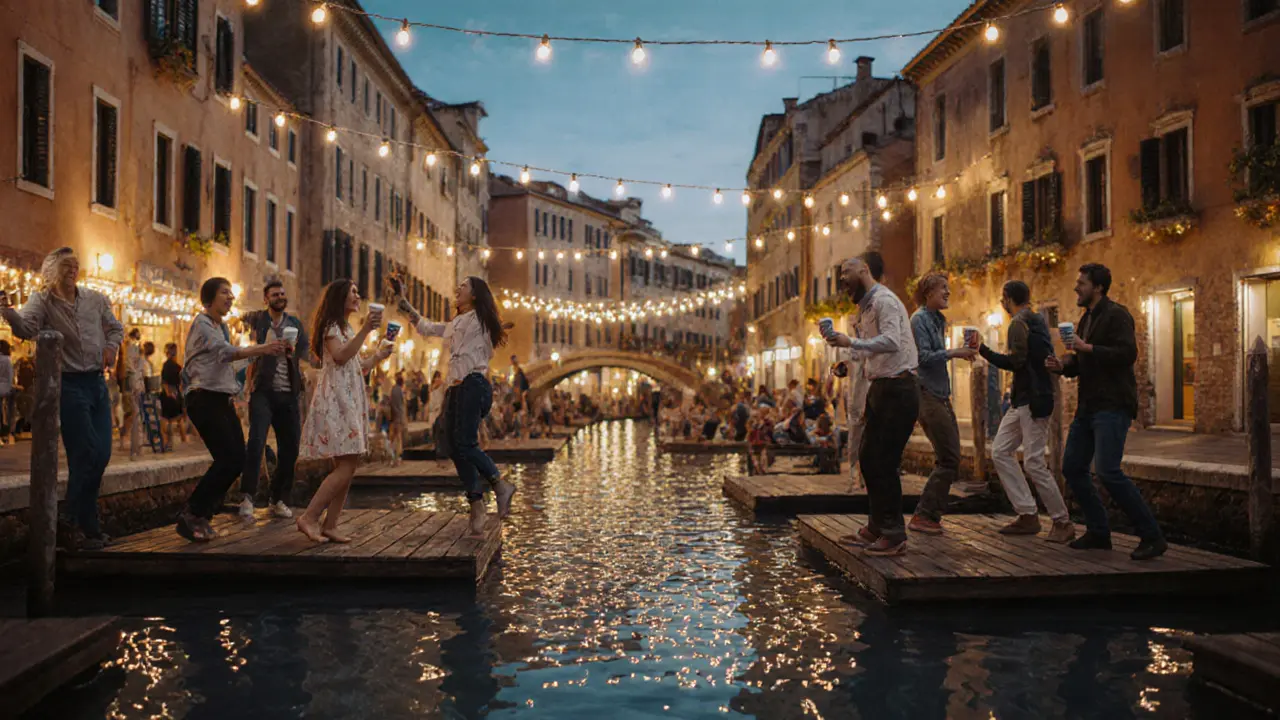Nightlife in Milan: The Ultimate Party Guide for Travelers

Millions of people visit Milan for fashion, food, and design. But when the sun goes down, the city transforms into something wilder, louder, and more electric. Forget what you think you know about Italian evenings. Milan’s nightlife isn’t just about sipping espresso at a sidewalk café. It’s about dancing until 6 a.m. in underground warehouses, sipping Aperol spritzes in hidden courtyards, and bumping into models and musicians in spots that don’t show up on Google Maps.
Where the locals actually go
If you want to feel like a Milanese, skip the tourist traps near Duomo. Head to Brera after 10 p.m. The streets here turn into a living room for artists, designers, and creatives. Bars like Bar Basso - where the Americano was invented - still serve cocktails with old-school charm. But the real action starts later. Around midnight, the crowd spills into smaller spots like Il Baretto or La Scala, where the music is vinyl-only and the crowd is all locals.
For something grittier, go to Navigli. This canal district is packed with outdoor terraces, live jazz, and pop-up bars. On weekends, the canals light up with string lights and people dancing on floating platforms. It’s not fancy, but it’s authentic. You’ll find students, expats, and Milanese grandmas all sipping wine from paper cups, laughing louder than the bassline.
Club scene: From underground to elite
Milan’s club scene splits into two worlds: the exclusive and the experimental.
On the elite side, Le Jockey and Magazzini Generali are the names everyone whispers about. Le Jockey is sleek, black-lit, and packed with international DJs. Entry is strict - no sneakers, no hoodies. Cover ranges from €25 to €50, but you’re paying for the vibe: top-tier sound systems, bottle service with champagne on ice, and a crowd that looks like it stepped out of a Prada campaign.
But if you want real energy, head to Ex Dogana or Officine Farneti. These are former factories turned into warehouse clubs. No bouncers in suits. Just a line of people waiting in the cold, holding tickets bought online. Inside, the music is techno, house, or industrial - loud enough to shake your ribs. The crowd? Mixed. Tourists, Berlin transplants, Milanese punks, and a few confused businessmen who wandered in by accident. These places open at 11 p.m. and don’t shut down until sunrise. And yes, you’ll see people dancing on tables.
Drinks that matter
You don’t come to Milan for overpriced mojitos. You come for the ritual.
Start with an Aperol Spritz - yes, it’s everywhere, but here it’s done right. Fresh orange slice, ice so cold it cracks, Prosecco poured slow. At Bar Basso, they make it with a silver spoon. At Bar Campari, it’s served with a side of history - the original Campari factory is just across the street.
Then there’s the Negroni. Not the cheap version you get in a hotel bar. This one’s made with gin from the Lombardy region, Campari from 1919, and sweet vermouth aged in oak. Ask for it “on the rocks” - never shaken. And if you’re feeling bold, try the Spritz Milanese: Aperol, sparkling wine, and a splash of bitter liqueur called Quinquina. It’s local. It’s obscure. And you won’t find it anywhere else.

When to go - and when to avoid
Milan’s nightlife doesn’t run on New York or London time. Dinner ends at 10 p.m. Bars fill up at 11. Clubs don’t get real until 1 a.m. If you show up at midnight expecting a packed dance floor, you’ll be standing alone with your drink.
Weekends are packed - especially Friday and Saturday. But Wednesday nights? That’s when the locals let loose. Officine Farneti has a Wednesday night called “Farneti Free” - free entry, no dress code, and a DJ who plays only rare 90s techno. It’s the best night to get in without a reservation.
Avoid Sunday nights unless you want to drink alone. Most clubs close by 2 a.m., and the bars start shutting down by midnight. It’s quiet. Too quiet.
What to wear - and what not to
Milan is Italy. Style isn’t optional. It’s survival.
At clubs like Le Jockey, you need to look like you own a wardrobe from Armani. No jeans. No sneakers. No baseball caps. Think tailored pants, a crisp shirt, maybe a leather jacket. Even women wear heels - not because they’re fancy, but because sandals and flats scream “tourist.”
At warehouse clubs? Jeans are fine. But if they’re ripped, make sure they’re designer ripped. Sneakers? Only if they’re clean, white, and from a brand like Nike or Adidas. No flip-flops. No tank tops. No visible logos unless they’re subtle. The rule? Look like you could afford to be here - even if you can’t.

How to get in - and how to avoid the lines
Getting into Milan’s best clubs isn’t about luck. It’s about strategy.
First, book ahead. Most top clubs - Le Jockey, Magazzini, Officine Farneti - don’t take walk-ins after 11 p.m. Use their websites. Some even have WhatsApp lists. Join them. You’ll get early access and sometimes free entry.
Second, go with a group. Solo travelers get turned away more often. Even if you’re alone, show up with two friends. The bouncer sees a group, not a lone tourist.
Third, dress like you belong. You don’t need to spend €500 on clothes. But if you show up in gym shorts and a hoodie, you’ll be politely asked to leave - and you won’t get a refund.
What to do after the clubs close
When the music stops, Milan doesn’t sleep. It just changes.
Head to Bar Basso again - yes, the same one. At 4 a.m., it’s empty, quiet, and still serving cocktails. Order a Negroni. Sit at the bar. Talk to the bartender. He’s been there since 1982. He’ll tell you stories about when David Bowie came in after a concert.
Or find a 24-hour espresso bar in Porta Venezia. Bar Pasticceria Cova opens at 5 a.m. They serve warm cornetti and strong coffee. No one’s dancing. No one’s loud. But you’ll feel like you’ve seen the real Milan - the one that wakes up before the sun.
Common mistakes travelers make
Don’t assume Milan is Rome or Venice. The vibe is different. Here, nightlife is about precision, not partying.
Don’t expect to walk into a club and get in. You need a plan. Don’t show up at 11 p.m. on a Friday expecting to dance. You’ll wait an hour in line and get turned away.
Don’t drink tap water. It’s fine to drink, but locals never do. Buy bottled. It’s €1.50. Don’t be the person who asks for free water at a bar.
And don’t try to haggle. Prices are fixed. If you complain about the €12 cocktail, you’ll get a look that says, “You’re not from here, are you?”
What’s the best night to go out in Milan?
Friday and Saturday are the busiest, but Wednesday nights are the most authentic. Clubs like Officine Farneti offer free entry on Wednesdays, and the crowd is a mix of locals, artists, and music lovers - not just tourists. If you want to feel like you’re part of the real scene, Wednesday is your best bet.
Is Milan nightlife safe for solo travelers?
Yes, but stay aware. Milan is generally safe at night, especially in popular areas like Navigli, Brera, and the Zona Tortona. Avoid walking alone in poorly lit streets after 2 a.m. Stick to main roads, use taxis or ride-sharing apps, and never accept drinks from strangers. Most clubs have security, and bartenders look out for guests.
Do I need to speak Italian to enjoy Milan’s nightlife?
No, but knowing a few phrases helps. Most bartenders and club staff speak English, especially in tourist areas. But if you say “Grazie” instead of “Thanks,” you’ll get a smile. A simple “Buonasera” or “Un Aperol Spritz, per favore” goes a long way. Locals appreciate the effort.
How much should I budget for a night out in Milan?
A casual night - drinks, a few snacks, and a club entry - will cost around €50-€80. If you’re going to a high-end club like Le Jockey, expect to spend €100-€150, especially if you’re buying bottles. Skip the tourist bars near Duomo - they charge double for the same drink. Stick to local spots in Brera or Navigli for better value.
Are there any age restrictions for clubs in Milan?
Most clubs require you to be 18 or older. Some high-end venues, like Le Jockey, enforce a 21+ policy, especially on weekends. Always carry your ID - even if you look older. Bouncers check passports, not just driver’s licenses. If you’re under 21, stick to bars and live music venues - they’re more relaxed.

Write a comment